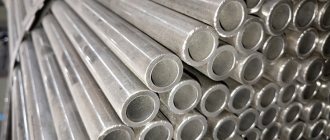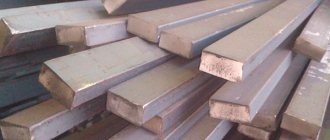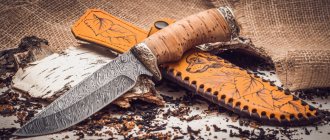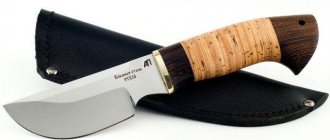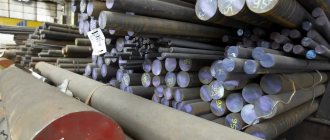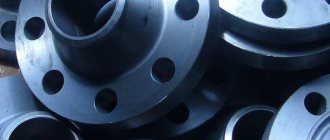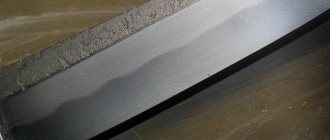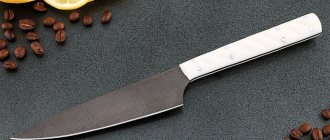cutting
| Initial data | Machinability Ku | |||
| State | HB, MPa | sB, MPa | hard alloy | high speed steel |
| hot rolled | 217–228 | 730 | 0,8 | 0,35 |
Technological properties of the X12 brand
Properties according to GOST 5950-2000 standard
Heat treatment: Hardening at temperatures of 940-970 °C, tempering - 180-250 °C, annealing - 800-830 °C.
Forging temperature: from 1100 to 850 °C, cooling is carried out slowly in wells.
| No limits | Limited | Difficult to weld | |
| Heating | No | up to 100-120°С | 200-300°С |
| Heat treatment | No | There is | annealing |
X12 steel – chemical composition
Mass fraction of elements no more than, %:
| Vanadium | Tungsten | Silicon | Manganese | Copper |
| 0,15 | 0,2 | 0,1–0,4 | 0,2–0,5 | 0,2 |
| Molybdenum | Nickel | Sulfur | Carbon | Phosphorus | Chromium |
| 0,2 | 0,4 | 0,03 | 2–2,2 | 0,03 | 11,5–13 |
Chemical properties
Two components are responsible for obtaining the final properties of a X12MF product: the chemical composition of the alloy and thermomechanical processing (intermediate and final). Naturally, both components depend on each other, and this subtle relationship is determined as a result of numerous studies and experiments:
- at existing metallurgical and machine-building enterprises;
- in metallographic laboratories.
The above products have high requirements:
- in terms of strength when processing metal using cold stamping and rolling;
- good heat resistance. — The set of these properties of the X12MF brand is ensured by a high concentration of the following elements, each of which brings its own characteristics:
- C - 1.45-1.65%;
- Cr - 11–12.5%;
- Mo - 0.4–0.6%;
- Si - 0.1–0.4%;
- V - 0.15–0.3%;
- Mn - 0.15–0.45%;
- Cu - 3%;
- Ni - 0.35%.
Explanation of steel X12MF
In this case, only the main elements are indicated in the labeling:
- index: X12 - chromium content 12%;
- M - molybdenum (without digital index, content should be up to 1%);
- F - tungsten (content also up to 1%).
Carbon is not indicated in this case, since by default its content is determined to be around 1.5%.
Carbon is the most important element that increases strength. His participation has both positive and negative effects. At the same time as strength, it reduces ductility, which makes the steel difficult to deform.
In addition, carbides at high concentrations are distributed unevenly, and also coagulate during further aging, which leads to heterogeneity of properties in the alloy itself: in the area of segregation, the alloy is strongest, and the depleted area becomes vulnerable when heated above 300 ºC. Therefore, during intensive work, when the working surface heats up, softening occurs.
But this deficiency is neutralized by adding chromium, manganese, molybdenum and tungsten.
The main alloying element of X12MF is chromium. It imparts corrosion resistance, increases hardenability and eliminates softening of steel. It is thanks to this chromium content that steel is characterized by high:
- heat resistance (no softening at high temperatures above 300 ºC);
- hardenability;
- resistance to warping during hardening.
Tungsten improves the cutting ability of steel, which is very important in the manufacture of knives. This is due to the ability of W to form refractory compounds, which, even when the cutting edge is heated, do not cause softening.
A high concentration of elements that increase strength gives the characteristics of steel negative qualities. They are neutralized by other elements, such as manganese and molybdenum. They also increase strength, but additionally work to increase hardenability (a property of steel that, when hardened, increases the thickness of the metal in which the necessary martensitic structure is formed). In addition, they reduce warping during hardening.
Vanadium, along with iron, forms VC carbides, which are characterized by even higher strength and refractoriness than FeC. Moreover, the content of this element in the range of only 0.3-0.5% does not reduce the ductility of steel.
Thermo-mechanical treatment
Molten metal is poured into molds to obtain:
- blanks of simple geometric shapes (circles, squares, etc.), from which parts are subsequently made by forging;
- finished products taking into account processing allowances.
When products are manufactured using the forging method, the structure is further improved. The changes that occur can be called an increase in density, because this eliminates defects:
- filling vacancies in the crystal lattice;
- dendritic segregation - grain refinement (elimination of the dendritic structure, which is inevitable during the crystallization of workpieces, ingots, increases plasticity, without loss of strength).
Complex molecular bonds in a saturated structure place high demands on temperature conditions. Heating of steel during forging should not exceed 1050 ºC. When the metal overheats, restructuring occurs, which causes brittleness; unfortunately, it is impossible to correct it.
The advantage of steel, such as low shrinkage, makes it possible to produce finished parts and precision workpieces by casting (dimensions taking into account allowances for processing). Then the final structure of the product is obtained by thermomechanical processing:
- Removing the excess layer ensures accurate dimensions and eliminates foundry costs;
- oil hardening increases the strength of the structure of the top layer;
- Vacation relieves internal stress.
Brand X12 - exact and closest foreign analogues
| Austria | England | Bulgaria | Germany | European Union | Spain | Italy |
| ONORM | B.S. | BDS | DIN, WNR | EN | UNE | UNI |
| BOHLERK100 | ||||||
| K100 |
| BD3 |
| X210Cr12 |
| 1.2080 |
| X210Cr12 |
| X210CrW12 |
| X210Cr12 |
| X21Cr12 |
| X120Cr12 |
| X210CM2 |
| X210Cr12 |
| China | Poland | Romania | USA | France | Czech | Sweden | South Korea | Japan |
| G.B. | PN | STAS | — | AFNOR | CSN | SS | KS | JIS |
| Cr12 |
| T30403 |
| T30404 |
| X200Cr12 |
| Z200C12 |
Steel X12MF, X12M, X12
The URALSPETSMETALL group of companies offers tool steel: circle X12MF, X12M, X12 , strip X12MF, X12M, X12, sheet X12MF, X12M, X12, forging X12MF, X12M, X12, square X12MF, X12M, X12, plates X12MF, X12M, X12, washers X12MF, X12M, X12, rings X12MF, X12M, X12 from stock and on order.
Short terms of registration and shipment if in stock . See warehouse balances. Check prices with our managers .
Possibility of making to order:
Legend
Mechanical properties
| HRСе | HB | KCU | y | d5 | sT | sв |
| MPa | kJ/m2 | % | % | MPa | MPa | |
| Rockwell hardness | Brinell hardness | Impact strength | Relative narrowing | Elongation at break | Yield strength | Short-term strength limit |
| Ku | s0.2 | t-1 | s-1 |
| Relative machinability factor | Proof of yield strength with 0.2% tolerance when loaded to plastic strain value | Torsional endurance limit (symmetrical cycle) | Endurance limit under compression-tension (symmetrical cycle) |
| N | number of deformation/stress cycles sustained by an object under load before fatigue failure/crack appears |
knives made of steel Х12МФ (D2/SKD11)
Even in the Soviet reference book on steels of the 195s, one of the recommendations for the use of X12M steel suggested the use of this steel for manufacturing. "knife blades". It was most likely about technological knives for woodworking enterprises or printing enterprises (cutters, stamps), but it is possible that numerous artels, which in the 50s were still producing table and utility knives, showed their interest in X12M (X12MF) steel . What could interest them?
In the photo: Finnish blade “Vacha” by master Dmitry Zainullin, made with a blade made of X12MF steel.
Initially, steel was intended for the manufacture of cold-formed tools (saws, woodworking knives, cutters, cutters...).
The steel contains 1.4-1.6% carbon and 11-13% chromium, which makes it quite resistant to humid environments, and the amount of iron carbides and proper heat treatment allow this steel to be hardened to 61-63 HRC. Foreign analogues of steel are designated D2 (American) and SKD11 (Japanese). And one of the most famous knife manufacturers, Bob Dozier (USA), worked almost exclusively with this grade of steel, achieving amazing results in its heat treatment.
Recently, in Russia, X12MF steel has become very popular for making knives. It is mainly small workshops and individual knifemakers who make their blades from it, but large eminent manufacturers have no particular desire to work with X12MF steel. And the point here is connected not only with certain difficulties in processing it, but also with certain disadvantages that owners of such blades face. Let's consider the pros, cons, chemical composition, and characteristics of X12MF steel.
pros
- High cutting characteristics (the cutting edge /hereinafter referred to as “RK”/ holds an edge for quite a long time);
- The RK is relatively easy to straighten/sharpen using diamond stones and a belt with GOI paste.
- Knives made from X12MF have “above average” characteristics and are quite affordable.
Minuses
- Relative corrosion resistance (pitting possible);
In the photo: pitting corrosion on a knife blade made of X12MF steel; a knife that has served well for many years in our office kitchen was left wet by company employees over the weekend, and a large stain on the blade of the knife is a lemon mark; fixing it is not a problem (sand it, polish it - it will be like new).
- Due to the high hardness of the steel, it is quite problematic to correct the RC in field conditions;
- Chips on the cutting edge are possible if the knife is used incorrectly, for example, when chopping on a bone.
Chemical composition
| steel grade | C | Mn | P | S | Cr | Si | Mo | Si | Ni | V | Cu | Fe | H.R.C. |
| X12MF | 1.45-1.65 | 0.15-0.45 | up to 0.03 | up to 0.03 | 11.0-12.5 | 0.1-0.4 | 0.4-0.6 | 0.1-0.4 | up to 0.55 | 0.15-0.3 | up to 0.3 | ≈84 | 61-63 |
Professional opinion
Andrey (Toledo), testing knives made of D2 Dozier steel, gave the following statement:
It should be noted the phenomenal cutting quality of the D2 knife from Dozier. The cut is aggressive, tasty, extremely original. Not the slightest hint of soapiness from beginning to end of the work. This is an honestly made knife with a strong character - an absolute highlight of any collection.
But here it is worth considering that the same Dozier devoted almost his entire life to heat treating and making knives from D2 steel. And in many tests that knife communities currently conduct, knives made of D2 steel (X12MF) sometimes take not only first, but also last place. Draw your own conclusion.
Who do we recommend?
For lovers of knives with an aggressive cut, who are not afraid of the necessary minimal care for knives made of X12MF steel (worked, washed, wiped, lubricated). Our recommendation for caring for Damascus steel knives will be on point here.
When working with knives made of X12MF steel, avoid significant lateral loads (especially with a small thickness of the blade spine), as well as chopping blows to the bone (but such blades cut branches and small growth “at once”).
You can use knives with blades made from this grade of steel almost everywhere, from a picnic and fishing to hunting, as well as professional activities. Keep the knife clean, periodically treat the blade with mineral oil, and use fine-grained diamonds, a leather belt and GOI paste for editing and sharpening.
When sharpening X12MF knives, choose the correct angle. Our recommendation is 35 degrees. But it all depends on the purpose of using the knife. Need sharpening advice? Write to the contacts listed on the website.
Well, and most importantly: when buying a knife made of X12MF steel, choose a well-known manufacturer. In this case, the knife will serve you for a very long time.
Heat treatment modes for steels Х12Ф1 (Х12М)
⇐ PreviousPage 16 of 41Next ⇒
| Mode | Temperature, оС | Cooling medium | Hardness, HRC (after hardening) | Amount of austenite, % | Holiday temperature, оС | Number of holidays | Hardness HRC (after tempering) |
| I | 1070±10 | Oil (saltpeter) | 62–64 | 20–25 | 160 | 1 | 62–64 |
| II | 1070±10 | Same | 62–64 | 20–25 | 200 | 1 | 58–60 |
| III | 1170±10 | Oil (saltpeter) + cold treatment at -70°C | 51–53 | 30–35 | 520 | 2–3 | 60–62 |
| IV | 1120±10 | Oil (saltpeter) | 57–59 | 35–45 | Thermal finishing | 57–59 | |
Note: I – normal mode; II – used if treatment according to mode I does not provide the required viscosity; III – for cutting tools when wear resistance is required; IV - used when size constancy is required.
Since in steel type X12 the amount of retained austenite varies widely (almost from 0 to 100%), the change in volume that is observed during hardening is also significant. When hardened to martensite, the steel acquires a volume greater than the original, and when hardened to austenite, it acquires a smaller volume (see curve Δl in Fig. 3.5). At a certain temperature, the ratio of the resulting austenite and martensite is such that the volume of the hardened steel is exactly equal to the original. As follows from the graph shown in Fig. 3.5, this will occur during quenching from 1120 °C, when about 40% of retained austenite is fixed at a hardness of about HRC 58 (in this case Δl = 0). However, possible fluctuations in the quenching temperature, cooling conditions and other details of the thermal regime, as a rule, lead to the fact that the dimensions of the die will not be exactly equal to the original ones.
If the dimensions of the die have decreased, then tempering is given at 520 °C. As a result of such tempering, the retained austenite will partially transform into martensite, and the dimensions of the die will increase. If the dimensions of the die have increased during hardening (the die has “grown”), then tempering is carried out at 350 °C. At these tempering temperatures, austenite remains, but tetragonal martensite turns into tempered martensite, and the dimensions of the die decrease.
This operation is called thermal finishing. As a result of thermal finishing, it is possible to bring the dimensions of large stamps to the required value with an accuracy of ±0.1 mm.
Steels Kh12F1, Kh12M and the like are slightly deformed during hardening, and when thermal finishing is used, deformation can be reduced to almost zero. Therefore, these steels should be recommended for tools of complex shape, for which deformation during hardening is unacceptable. A significant disadvantage of X12 steel is its reduced mechanical strength, due to the presence of a large amount of carbide phase in this steel. Since the more carbides there will be, the more carbon there is in the steel, X12 steel (with 2.0–2.3% C) is used only for tools that are not responsible for their intended purpose and for tools that are simple in design.
For X12 steels, as well as for high-speed steels, the distribution of the carbide phase is of great importance. The line distribution of carbides, the accumulation of carbides, i.e., everything that is called “carbide segregation” greatly impairs the strength of steel. The more bends, and therefore the smaller the cross-section of the metal (workpiece, rod), the more the accumulations of carbides are crushed, the better the quality of the steel (Fig. 3.6, a, b). Therefore, thorough forging should be recommended in cases where the stamp is large. Forging in this case is achieved by alternating upsetting and drawing. However, it is not always possible to eliminate “carbide segregation” to the required extent.
Steel of the class under consideration, but with a lower content of carbon and chromium and less prone to carbide segregation, is designated as X6VF. It contains less carbides than XI2 steel (12–14% Cr7C3 carbide in annealed Kh6VF steel versus 15–17% in Kh12F1 steel and 25–30% in Kh12 steel), and, other things being equal, it has less carbide segregation (Fig. 3.6, b).
Rice. 3.6. Microstructure of steel, ´ 100:
a – X12; b – Х6ВФ
The behavior of Kh6VF steel during heat treatment is the same as that of steels of the X12 type, however, an increase in the quenching temperature does not lead to such a sharp dissolution of the carbide phase as in steels of the X12 type. Therefore, this steel is usually hardened from 1000±10 °C (to obtain maximum hardness). In this case, about 8% of the 12% carbides will go into solution, and martensite will contain about 5% Cr.
This martensite is quite resistant to tempering. Tempering at 200 °C reduces the hardness to HRC 58, and a further increase in temperature (to 500–525 °C) reduces the hardness to a slight extent - from 58 to 55–56 HRC. Since strength and toughness also change little in the same tempering temperature range (this change in properties is also typical for steels of the X12 type), Kh6VF steel is tempered either at 150 °C (to maintain high hardness) or at 200 °C (for some higher hardness). viscosity). It follows from this that the areas of application and heat treatment modes of Kh6VF and Kh12F1 steels are generally similar, only Kh6VF steel has higher strength, but lower wear resistance, which is a consequence of the smaller amount of carbide phase in it.
⇐ Previous16Next ⇒
Recommended pages:
Characteristics of steel Kh12F1
Knowing the exact composition of steel, it is possible to determine its general characteristics with a certain degree of error.
- The first thing I would like to note is that the steel is high-carbon, which means it is extremely durable. This is not surprising, because its task is to bend, cut and press metal.
- It is also chrome plated. This, firstly, protects the part from deformation during corrosion, and secondly, makes the steel less sensitive to high temperatures.
- It has a very complex internal structure. When stamping parts, a lot of pressure is applied to the stamp itself, and any microcrack or any other defect can lead to very disastrous consequences.
- X12F1 steel feels quite comfortable in environments with elevated temperatures. This is facilitated by a whole bunch of ligature elements and their compounds.
